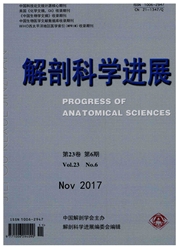

 中文摘要:
中文摘要:
目的探讨氨基糖甙类耳毒性药物暴露下小鼠内毛细胞传入神经突触后谷氨酸受体表达水平的变化,以及这种变化和小鼠听功能改变之间的关系。方法选择5周大小的C57BL,6J小鼠,每天腹腔注射庆大霉素1次,药物浓度为100mg/kg,连续给药14d,分别在第7天、第14天时检测受试小鼠的ABR(Click & Toneburst),并以未进行腹腔注射给药的小鼠(0d)作为对照组。使用抗GluR2/3抗体对小鼠基底膜铺片标本进行染色标记,以观察耳蜗内毛细胞传入神经突触后谷氨酸受体(GluR2/3)的表达情况。结果注射庆大霉素小鼠在第7天、10天、14天时听力损失明显,听力阈值显著高于对照组(P〈0.05)。应用庆大霉素后第7天和14天,耳蜗内毛细胞传入神经突触后谷氨酸受体(GluR2/3)的表达水平和对照组相比显著增高,听力损失最为严重,提示GluR2/3在突触后的过高表达和耳聋程度存在相关性。结论氨基糖甙类耳毒性药物持续暴露可以造成耳蜗内毛细胞传入神经突触间隙内谷氨酸递质过表达,与耳聋程度呈正相关。
 英文摘要:
英文摘要:
Objective To investigate the alteration of AMPARs expression level at cochlear ribbon synapses induced by aminoglycosides ototoxicity exposure, as well as the possible relationship with auditory functional decline. Methods Gentamycin snlfate(100mg/kg) was injected intraperitoneally into five weeks C57BL/6J mice once a day for 14 days consecutively, the auditory function(Click & Tone burst) was determined at 7th and 14th day respectively, the mice without treatment served as a control group(0d). The cochlear basilar membranes of mice were stained by anti- GluR2/3 antibody to observe the expression alteration of AMPARs at afferent postsynaptic membrane of inner hair cells(IHCs). Results Gentamycin sulfate injection caused the increase of hearing ABR threshold and serious damage of hearing function at 7th d, 10th d and 14th d after aminoglycosides ototoxicity exposure. In addition, the expression level of GluR2/3 was significantly increased at 7th and 14th d after aminoglycosides ototoxicity exposure compared with the control group, with positive correlation with the shifts of hearing threshold. Conclusion Aminoglycosides ototoxieity exposure could cause overexpression of glntamic acid receptor in ribbon synaptic cleft, with positive correlation with the shifts of hearing threshold.
 同期刊论文项目
同期刊论文项目
 同项目期刊论文
同项目期刊论文
 期刊信息
期刊信息
